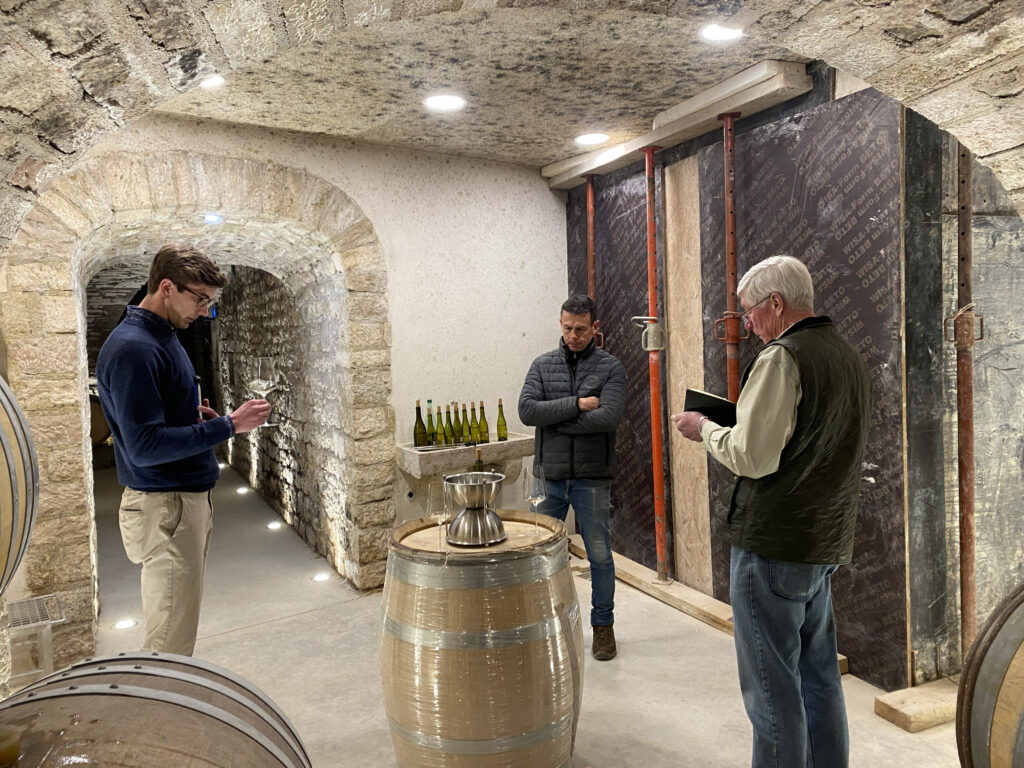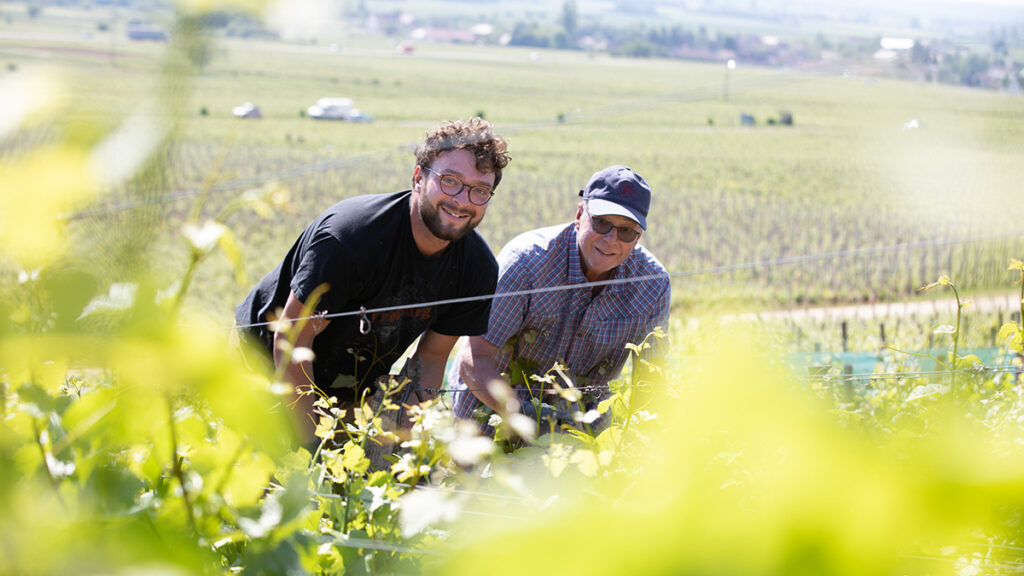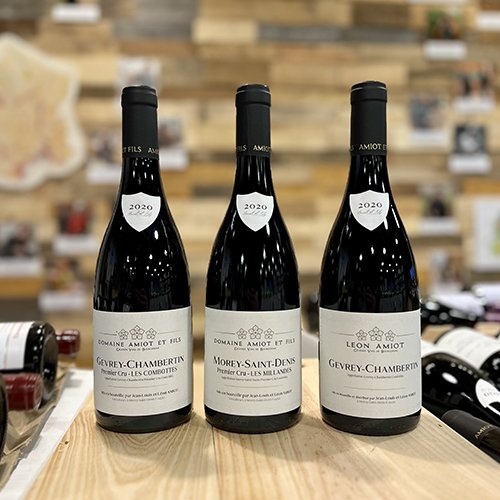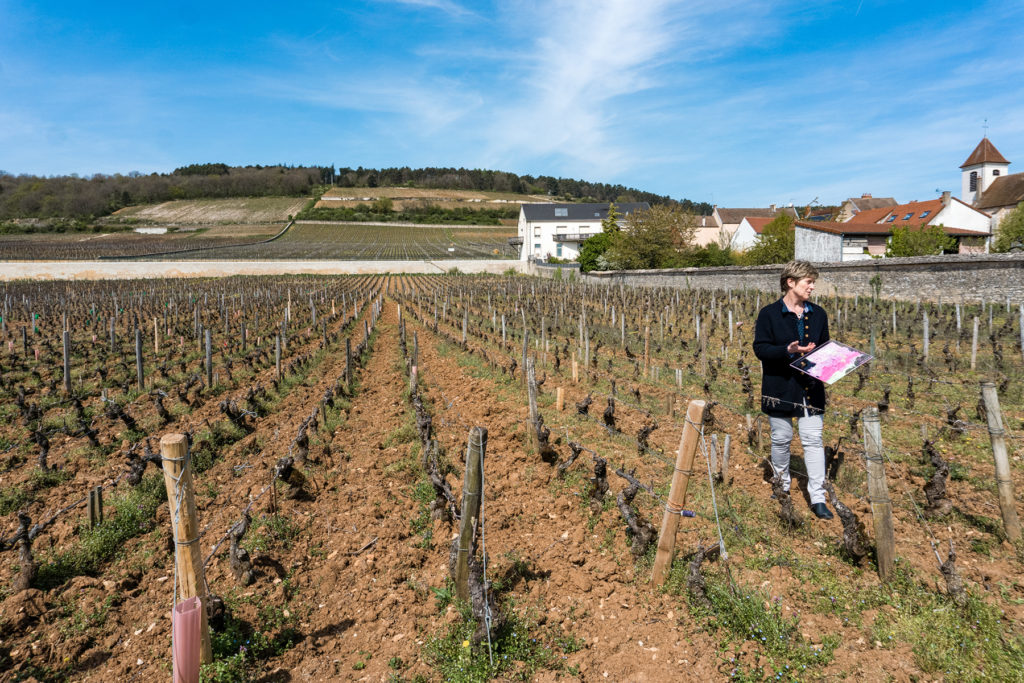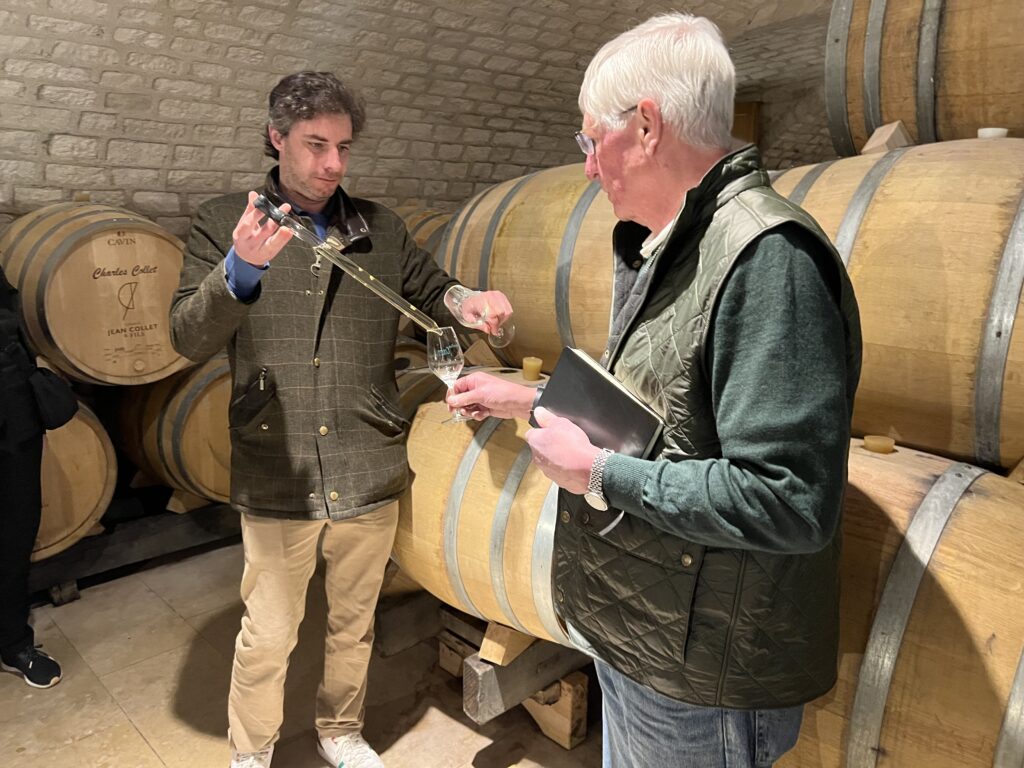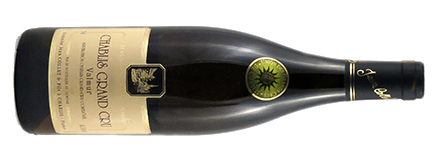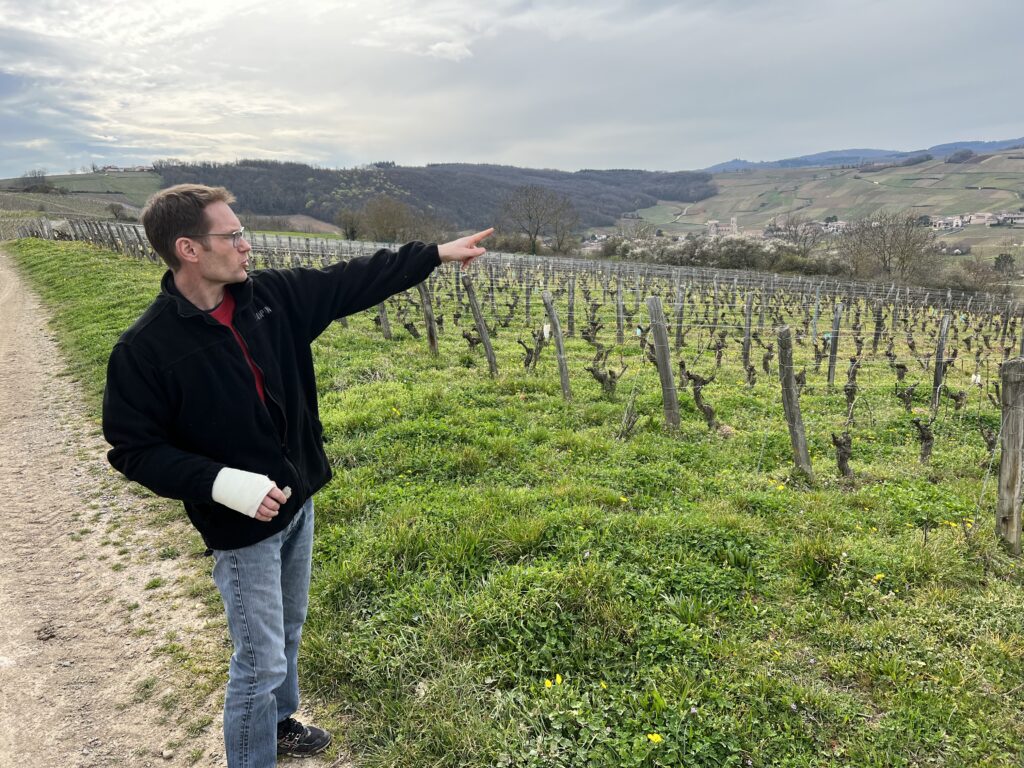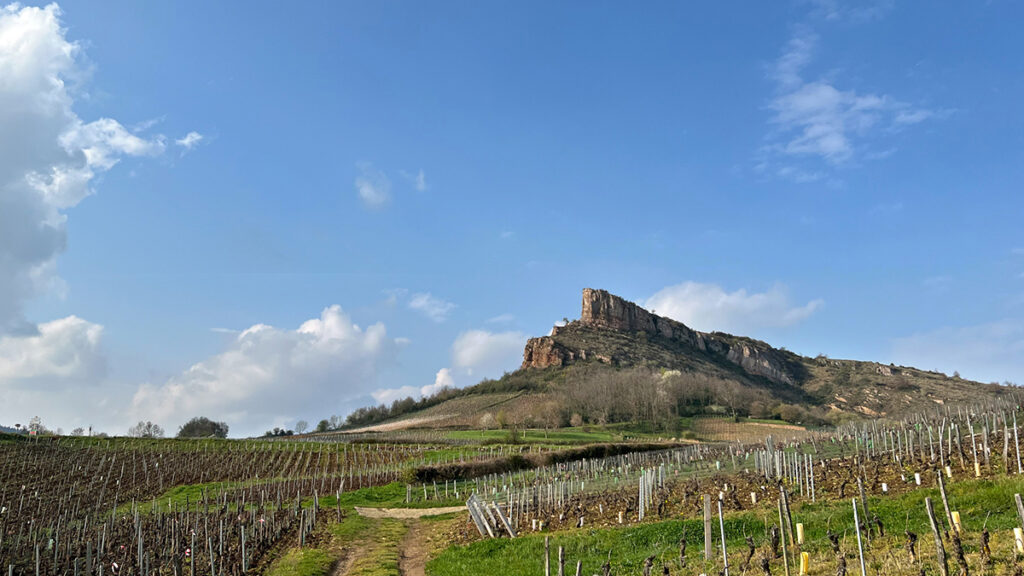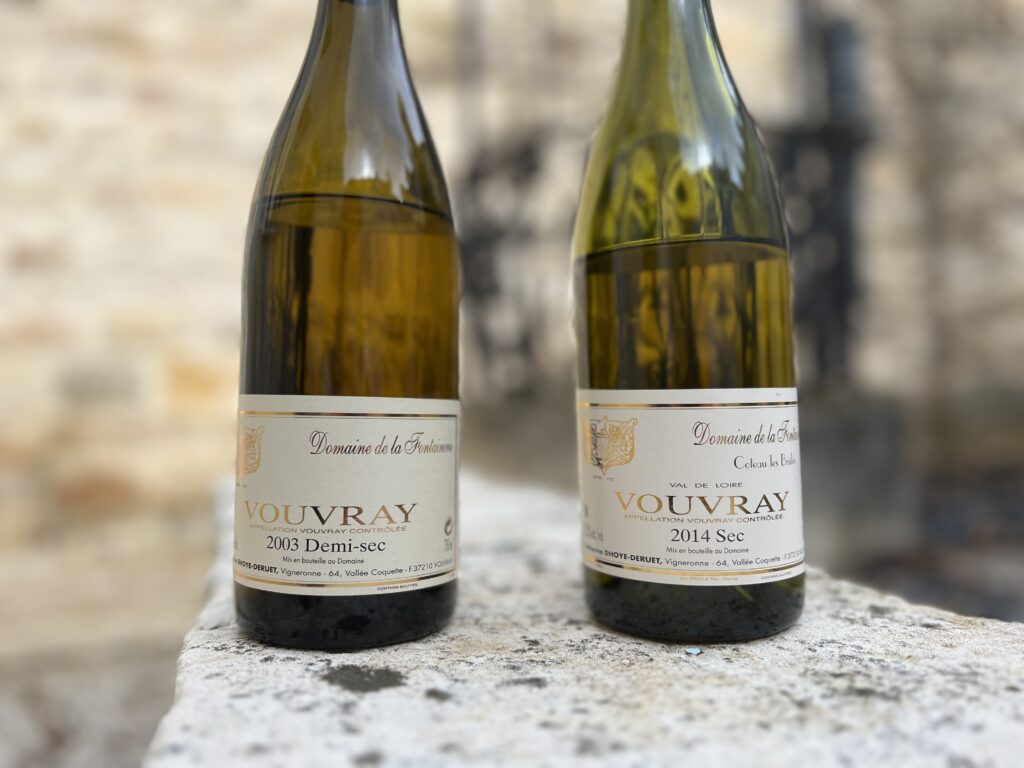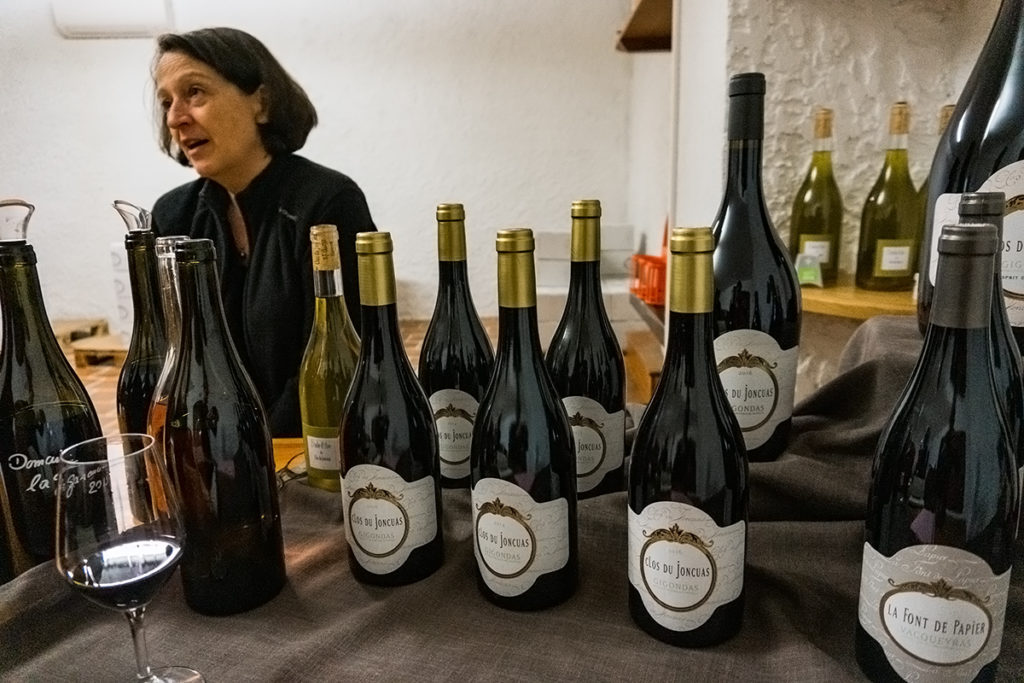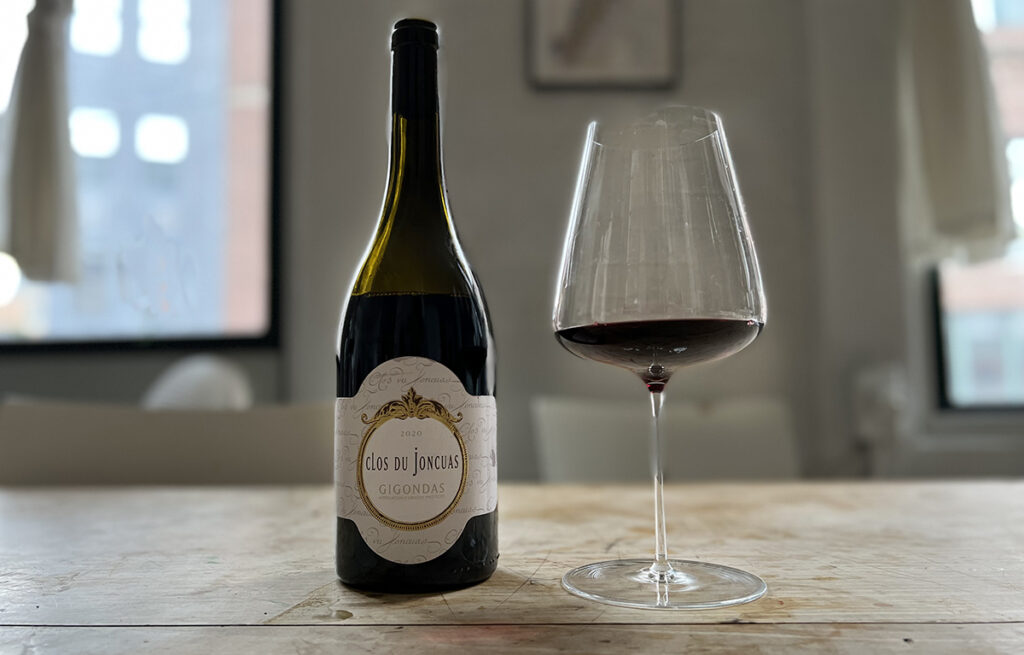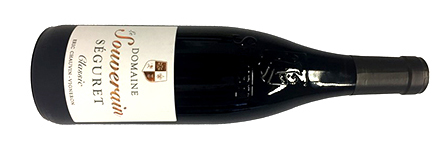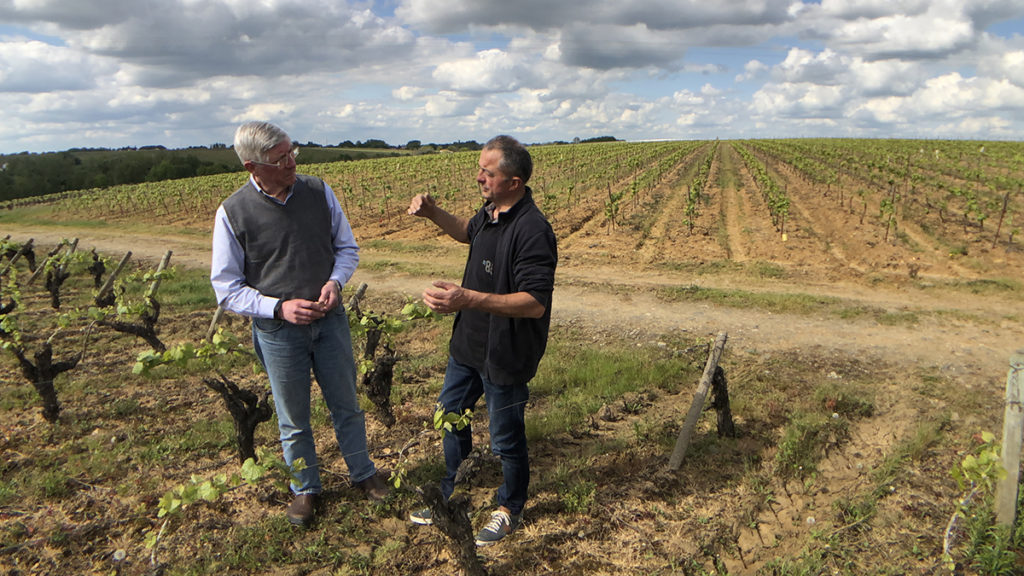Our visit to France in March revealed far more relaxed vignerons than we found there last Spring. Last year one could sometimes sense fear as nearly empty barrel rooms starkly illustrated the impact of a very small vintage (2020) followed by a genuinely tiny one (2021). Happily for all of us, winemakers and wine buyers, nature came through in 2022 with a vintage of both quantity and quality. We suspect that everyone is sleeping a bit better this year, particularly in Burgundy. We also have the sense that vignerons feel better now about their ability to deal with a warming world. Changes in vineyard management are steadily taking hold, whether from the simple and now common practice of pruning later to delay the vegetative cycle, or from more complicated changes to improve the health and resilience of soils, subsoils, and root systems; or from changes in vine and rootstock selection. There is more optimism about a path forward that can both address climate change and preserve the unique character of France’s greatest terroir. For our part, we were delighted to sample the excellent quality that the best producers were able to achieve in 2021, a growing season with plenty of sleep-challenged nights for the vignerons. In short, our March visit left us confident that there is a bright future for the vineyards and vignerons of France, and we’re excited to share our ideas with you. May Futures includes, as usual, a healthy dose of Burgundies — from the Côte d’Or, from Chablis, and from the Maconnais. There is also wine from the Southern Rhône and from two different stretches of the Loire Valley, including a new source in Vouvray, and a single entry from Bordeaux. We hope there will be something here for every taste and budget. If you find anything of interest, be sure to submit your orders, in case or half-case lots, by the Order Deadline of Sunday, May 21, 2023. We will place orders for the wine immediately thereafter. JUMP TO VIGNERON
Amiot
T. Morey
Collet
Giroux
Fontainerie
Joncuas
Souverain
Martin-Luneau
Fleuron de Liot
May Futures
Order Deadline 5/21
Domaine Amiot et Fils
Morey-St-Denis, Burgundy
It is always interesting to watch a family business make the transition from one generation to the next, and in Burgundy today it is particularly so. Producing fine Burgundy has long been an effort of multiple generations, with “père et fils” (or now “fille”) a common label feature. As wine buyers and regular visitors to the region, we see many families dealing with today’s challenges: a warming climate, the move away from chemical-focused vineyard management, and new techniques in the cellars. Not to mention the complexities of a dynamic global marketplace and tricky French inheritance laws. The best transitions happen when the parents are open to new ideas and the children see the value in their parents’ experience. That is clearly happening at the newly reconstituted Domaine Amiot et Fils. You only need to walk to the back of the winery buildings to find garden-sized experiments in canopy and trellising, soil management, and other new approaches. Most producers discuss viticulture techniques with their fellow vignerons; far fewer have their own 9-row laboratoire (complete with free-range chickens) in the backyard. Léon and his parents seem entirely in sync, and if the results of the first two vintages are a good indication, this domaine will be going from strength to strength. As we have written, the 2021 vintage is a tiny one, where early frosts and a challenging growing season reduced the size of the crop at every turn. But domaines who met the challenges well produced excellent wine. We are delighted with what the Amiots have in the bottle for 2021, and we only wish there were more of it. Across the range, the Amiots’ 2021s are attractive, true to terroir and destined to drink well before many of the bigger vintages of recent years. At the entry level there are now two wines. The recent addition is Côteaux Bourguignon, a blend of Pinot Noir and Gamay. It is a pleasant and straightforward cuvée with attractive ripe fruit that will be accessible from the day it arrives. The gamay brings a pleasant rusticity and this falls just about where you’d guess – somewhere between a cru Beaujolais and a regional Bourgogne. The classic Bourgogne Côte d’Or rouge is all Pinot Noir, and the fruit is lovely, with good lift and an expressive nose that will provide excellent drinking while the more serious cuvées are knitting together in your cellar. It’s classier and finer than the Coteaux, but no less charming. At the village level there are two wines to suggest: Gevrey and Chambolle. The 2021 Gevrey-Chambertin was vinified with a small amount (15%) of whole clusters, and shows the darker fruit that is characteristic of the village. Allen Meadows (“Burghound”) found “aromas of red cherry, earth, and a suggestion of the sauvage.” Like the Chambolle it is an elegant wine, with maybe a bit more complexity and seriousness; but it should drink well very soon and for five years thereafter. The Chambolle-Musigny 2021, from purchased grapes, is a lacy wine, nicely concentrated but also very elegant. The nose is dark and floral, with a nose of anise and violets; the mouth is chalky and elegant. It should drink well after only a brief rest to settle down from its voyage, and we’d be surprised if anyone can keep their hands off it longer than two years. The premier crus are all excellent in the 2021 vintage. The Morey St. Denis 1er cru “Charmes,” from old vines immediately next to the Grand Cru Charmes-Chambertin, is charming as usual, with a ripe nose that is just lovely. The tannins are supple and well-integrated. Burghound praised its “very good energy” and its “inviting, cool, and nicely balanced finale.” He thought that as a “wine of finesse” it would benefit from a few years of cellar time. It’s a classic Morey-St-Denis in a classical vintage. As usual, the Morey St. Denis 1er cru “Millandes” is a sturdy wine with plenty of structure. Burghound awarded the 2021 his “particularly outstanding” designation and opined that it should repay a decade or more of cellaring. He found “both excellent volume and solid concentration” and a “gorgeous mouthfeel,” and praised its “cool, pure and complex aromas of freshly crushed red berries, spice, and a hint of violet.” We agree and found it beautifully coiled, elegant, and firmly stony – it’s perhaps the wine that Léon has enhanced the most in his brief tenure so far. This will not be a wine to pop open on the day it arrives, but with some time at the back of the cellar it will be a beautiful example of Morey St. Denis’s depth and complexity. The Morey St. Denis “Les Ruchots” 1er cru 2021 – from the town’s finest premier cru (above) – is rich and complex, with its structure masked by exceedingly fine-grained tannins. As usual, it seems to share some of the density and complexity of its Grand Cru next-door neighbors (both Clos de Tart and Bonnes Mares), and is clearly the best Morey premier cru of the Amiot lineup. Burghound found that “aromas of plum and various dark berries are also trimmed in a discreet application of wood.” We thought the wine rich and complex, and expect it to be among the best bottles in our cellar in the fullness of time. While we’re on the subject of premier crus that might well be taken for a Grand Cru, consider the Gevrey-Chambertin 1er cru “Les Combottes,” a vineyard surrounded by Grand Crus on all sides. We always love this wine, and 2021 is no different. Like Ruchots, its very fine-grained tannins offer substantial structure without a bit of harshness. The power and intensity is remarkable, with a finish that goes on for miles. Burghound found it “ wonderfully refined thanks to the even finer tannins,” concluding simply: “A wine of grace and finesse.” It is a wine that will pay keeping and match special dinners for many years to come. Finally, the Grand Cru Clos de la Roche is a stunner in 2021. When we tasted it in March we were struck by the beauty of the nose, the deep, dark fruit, and the fine structure. Burghound gave it 91-94 points and praised its “spicy nose of plum, dark currant and humus.” He found “fine volume and punch to the caressing yet powerful middleweight flavors” and an “impressively lingering finale.” There is a lot of wine in one of these bottles, and for those with the patience and budget, it will be a fine addition to the cellar.
AMIOT Coteaux-Bourguignons 2021: $275 Morey-St-Denis 1er “Charmes” 2021: $995 Clos de la Roche Grand Cru 2021: $3495
(case prices)
Bourgogne rouge 2021: $350
Gevrey-Chambertin 2021: $795
Chambolle-Musigny 2021: $950
Morey-St-Denis 1er “Millandes” 2021: $995
Morey-St-Denis 1er “Ruchots” 2021: $1095
Gevrey-Chambertin 1er “Combottes” 2021: $1395
Thomas Morey
Chassagne-Montrachet, Burgundy
For the 2021 vintage, our offer list is a good deal shorter than usual at the Domaine Thomas Morey. That’s not because of anything wrong with the missing wines, but because our allocation this year is a single case for a number of the wines that we usually buy. The Côte de Beaune was among the hardest hit areas in the frost-decimated growing season of 2021, and Morey’s standards are such that only the very best and cleanest surviving grapes found their way into the fermentation. The good news is that the wines that made it into the bottle are just delicious, showing the classic Thomas Morey style: focused and precise, with beautiful profiles and the promise of great things as the wines round out and integrate. Think of it as “minimalist white Burgundy,” nothing there that doesn’t need to be, and the few elements remaining working in quietly perfect harmony. Our first suggestion is Morey’s Chassagne-Montrachet 2021, a wine assembled from seven parcels on the north side of the village. The wines of Chassagne generally have more weight than those of their next-door neighbors in Puligny, and they are often praised for their “weight without heaviness.” This is always the case with Thomas Morey’s Chassagne — there is plenty of concentration and length, but it always comes with elegance and character. That is particularly so in the impressive 2021 vintage. Jasper Morris MW (“Inside Burgundy”) was as impressed with this wine as we are. He found a “fine bouquet, with a lift and a delicacy in the aromatics. Quite floral for Chassagne.” Summing up, he said: “this is very stylish, very precise, with a good long even finish, including very light fresh citrus.” Enough said. There are two wines at the premier cru level, a level that delivers more concentration and flesh than village wines. Chassagne-Montrachet 1er cru “Les Embrazees” comes from the middle of the slope — just above Roger Belland’s Monopole “Clos Pitois” and just below the premier cru “Les Baudines.” Morris said “there is plenty to be going on with here,” including “that feeling of lemon curd on the fruit profile.” Thomas Morey’s great grandfather was the first in the family to plant vines in this vineyard, and we have been drinking it for a couple of decades now. It begins to drink well after the village wine but earlier than Morgeot, the other premier cru on offer. But there’s no rush to open these bottles — when we visited in 2019 with a number of customers, Morey opened a thirty year old magnum from the family cellar. It was delicious. The second premier cru is from the Morgeot sector of Chassagne, a series of climats that lie further down the slope, where the soils are deeper and carry a bit more clay. These make for more powerful wines, ones that require a bit more patience but reward cellaring particularly well. Jasper Morris praised its “glowing pale yellow with a primrose tint.” He found a “bouquet full of energy” and “plenty of weight across the palate, a mix of fruit, white, greengage and citrus, with pleasing length.” He suggests beginning to drink it in three years. Thomas Morey has a single wine from Puligny-Montrachet, but it is a particularly nice one: Puligny-Montrachet premier cru “La Truffière.” Puligny generally needs more time in the cellar than does Chassagne, but particular fans of airy elegance should consider putting some of this in theirs. Jasper Morris found “significant intensity here, building to the back of the palate. All in white fruit, a fine chiseled mineral backbone, and good length.” There will be plenty of floral notes with the fruit in this wine, and you should bring one out when you want to match an elegant dish with a refined and elegant wine. We are pleased to have been offered a tiny quantity of Thomas Morey’s Grand Cru Bâtard-Montrachet 2021, which Jasper Morris awarded 94-96 points. Given both the price and the quantity, we are offering this wine by the bottle. With a great Grand Cru early tastings are an exercise in projection, but we could readily see the intensity, length, and concentration in this wine. Jasper Morris predicted great things for it: “Very much a baby and I suspect there is more here than immediately meets the eye. Certainly, the exceptional persistence suggests so. Attractive aromatics in the empty glass are promising too. Drink from 2028-2036.”
MOREY Chassagne-Montrachet 2021: $695 Chassagne-Montrachet 1er “Embrazées” 2021: $850 Batard-Montrachet Grand Cru 2021: $3495
(case prices)
Chassagne-Montrachet 1er “Morgeot” 2021: $850
Puligny-Montrachet 1er “Truffière” 2021: $1295
Jean Collet
Chablis, Burgundy
Romain Collet continues to produce wines that belong in Chablis’s top tier. He has been experimenting with new techniques of elevage for a number of years now — eggs, amphorae, and barrels of different sizes can be found all across the family’s cellars — and the results are impressive. We got our first look at the small 2021 vintage a year ago, and were so impressed we reserved some premier cru well in advance to be sure of getting a reasonable supply. (Good thing too; we’re not the only Collet fans out there, and our allocations here have become stricter each year.) Finally in the bottle, the wines continue to impress. Collet’s village level Chablis always offers excellent value. The 2022 vintage was a success in Chablis as it was in the Côte d’Or, with generous quantity and good ripeness. As usual, Collet’s Chablis 2022 was vinified and raised in stainless steel. It is round and supple, with attractive lemon fruit and a nice mineral line. There’s a delicious dose of classic Chablisien stoniness alongside the fruit. It should drink well immediately and for the next few years. The Chablis Montmains Premier Cru 2021 was also raised entirely in stainless steel, but there is more concentration and length than in the village wine. It is more a classic Chablis, precise and focused with great tension and excellent zip. Burghound loved this cuvée, finding “volume and refinement” with a lovely minerality on the lingering, balanced and delicious finale,” concluding “with a few years in bottle it could be excellent”. Vaillons Premier Cru 2021 comes from a very large family holding (9 hectares or 20 acres) in this well-known left-bank vineyard. Romain has settled on an elevage of ⅓ barrels, ⅓ foudre, and ⅓ tank, and it suits the vineyard very well. The vines here are between 55 and 60 years old, and they produce a nicely balanced wine, with good concentration and well-supported ripeness. Jasper Morris found the bouquet “both stylish and typical, stones with lemon zest.” Allen Meadows (“Burghound”) praised its “cool and airy aromas,” its “intense and attractively sleek” flavors, and its “lovely minerality.” This is a very versatile white that works equally well with roast chicken, pasta with clams, or a sauteed filet of fish. There are sub-climats within both Montmains and Vaillons, and Romain has begun to bottle some of these separately. For those who like a Chablis whose texture recalls the wines of the Côte d’Or, we suggest Fôrets Premier Cru 2021. Forêts is near the top of the Montmains vineyard, but its vines lie in a draw that tends to accumulate warmth and so round the wine out. This cuvée is raised in cement eggs, and the natural circulation of the lees adds richness and complexity. Jasper Morris found it “on the richer yellow fruit side,” with “substantial volume on the palate.” Burghound was particularly impressed with this wine (and with Montée de Tonnerre below), awarding both his designation of “particularly outstanding for the appellation.” Montée de Tonnerre Premier Cru is Chablis’s best known premier cru, and Collet’s 2021 Montée de Tonnerre is particularly good. This wine is raised in small oak barrels, so the wood is noticeable, but both Morris and Burghound found it an enhancement. Morris: “Quite a wealth on the palate, on the cusp between white and yellow, then a buttery oaky quality to finish – but absolutely not interfering with the fruit.” Meadows: “Discreet but still noticeable wood easily allows the elegant floral-suffused aromas of mineral reduction, lemon rind and sea breeze.” We found this wine outstanding this vintage, and every bit worthy of its reputation. The Collet family is fortunate to have plots in two of Chablis’s Grand Cru vineyards. Pricing for Chablis Grand Cru is by far the best of Burgundy’s Grand Cru whites, and both Grand Crus from Collet are worthy of a place in any collector’s cellar. The larger plot, which has been in the family for some time, is in Valmur Grand Cru. The Valmur 2021 offers a noticeable increase in complexity, concentration, and length from the premier cru wines of the vintage. Burghound found “aromas of green fruit, citrus, iodine and shellfish,” praising its “powerful big-bodied flavors” and its “complex, balanced, and muscular finale.” Morris suggested starting to drink the 2021 Valmur in 2025, a year earlier than 2021 Les Clos. The smaller Grand Cru parcel is in the best-known Grand cru vineyard, “Les Clos.” Jasper Morris called the 2021 “a Les Clos of considerable promise,” with “excellent length for the vintage, or indeed against any standard.” Burghound praised its “floral suffused nose” and thought it the “biggest wine in the range,” with “impressive volume,” “abundance of minerality,” and “well-structured finale.” You won’t go wrong with either wine.
COLLET Chablis 2022: $295 Chablis 1er “Montmains” 2020: $375 Chablis Grand Cru “Valmur” 2021: $750
(case prices)
Chablis 1er “Vaillons” 2021: $395
Chablis 1er “Forets” 2021: $395
Chablis 1er “Montée de Tonnerre” 2021: $395
Chablis Grand Cru “Les Clos” 2021: $795
Sebastien Giroux
Pouilly-Fuissé, Maconnais, Burgundy
When we lived in Burgundy two decades ago we spent a lot of time in Pouilly-Fuissé. It is dramatic terroir, the slopes framed by the Rock of Vergisson and the Rock of Solutré, two cliffs jutting skyward dramatically at either end of the vines. It has wonderful soils and exposition, too, and during our time in France we found a superb winemaker who made gorgeous white Burgundy that could hold its own with the great whites of the Côte d’Or. We imported his wines for years until we lost him to that most Gallic of maladies: retirement. But with last year’s discovery of Sebastien Giroux, we think ourselves once again in a position to offer the best of that fabled terroir. Giroux is a disciplined and principled winemaker who doesn’t let the calendar control his timing. He bottles each wine when he thinks it is ready, and not before. Thus we have three different vintages to suggest, each with its own virtues. The first is from a plot just outside the Pouilly-Fuissé appellation. Macon-Fuissé “Vers Chanes” 2021 is a wine that is has both lively freshness and depth; and its nose mingles Muscat-like notes with ripe lemon. The 2019 of this was a hit last year, and this year’s is just as good. With a Futures price just under $20, it is an excellent value . From the 2019 vintage we have two ideas, the first from the little known appellation of Pouilly-Loché. This appellation is to Pouilly-Fuissé as St-Aubin is to Chassagne: less famous, but often just as good. The Pouilly-Loché 2019 “Au Bucher” is from 70 year-old vines, resulting in plenty of richness and excellent balance. About 40% of the cuvée was raised in oak (large barrels), which adds a just a hint of wood for more complexity. Jasper Morris found “quite sumptuous ripe apple and yellow fruit, but with enough acidity and good length, with “a feel of granitic tension to finish.” We found this beautifully balanced, and now over three years on from harvest, a mature, overperforming white Burgundy. We also recommend Giroux’s Pouilly-Fuissé 2019, which we thought was showing particularly well when we tasted it at the domaine in March. William Kelley found notes of “pear, almonds, and fresh pastry,” and praised its “bright spine of acidity” and “precise finish.” We think it is all grown up now and ready to accompany all sorts of dishes that call for a refined white wine. This the inverse of the over-produced, over-oaked Pouilly-Fuissés of old. There are three wines from Pouilly-Fuissé to tempt you from the 2020 vintage. Last year we brought in the 2019 Pouilly-Fuissé “Les Raidillons.” It was so compelling we went back to the domaine to beg the last nine cases. “Les Raidillons” 2020 is a worthy successor. Last fall Kelley called Raidillons 2020 “another success, mingling aromas of fresh orchard fruit and white flowers with scents of beeswax and freshly baked bread,” awarding 92 points. We also loved Giroux’s old vine cuvée, Pouilly-Fuissé “Vieilles Vignes” 2020, which was raised entirely in oak barrels and bottled at the end of 2022. It is mouth filling wine, another notch up in intensity and depth. Kelley gave it 93 points, calling it “ample and satiny, with lively acids and a vibrant, fleshy profile.” With the 2020 vintage the premier cru designation has finally arrived in Pouilly-Fuissé, and Giroux’s Pouilly-Fuissé 1er cru “Les Vignes Blanches” is unmistakably on another level. It is just lovely, a big wine with all sorts of richness and length. It balances long, luxurious fruit with a finely chiseled structure in a way that calls to mind Puligny-Montrachet. Kelley gave 93+ points, finding it “wafting from the glass with scents of crisp yellow orchard fruit, freshly baked bread, vanilla pod, fresh mint and classy new oak.” He praised it as “full-bodied, ample and satiny, with racy acids, chalky structure and a penetrating finish.” The appellation has been twenty years coming up with a list of wines to award the premier cru designation, and this wine certainly belongs in the group.
GIROUX Macon-Fuissé “Vers Chanes” 2021: $235 Pouilly-Loché 2019: $295 Pouilly-Fuissé “Raidillons” 2020: $350
(case prices)
Pouilly-Fuissé 2019: $295
Pouilly-Fuissé Vieilles Vignes 2020: $395
Pouilly-Fuissé 1er “Vignes Blanches” 2020: $495
Domaine de la Fontainerie
Vouvray, Loire Valley
We’re excited to share a new discovery in the Loire Valley: Domaine de la Fontainerie. Located in Vouvray in the central Loire Valley, Fontainerie is a small 6-hectare estate producing delicious wines of pure Chenin Blanc. The winemaker is Catherine Dhoye-Deruet – she’s run the place since the 90s, and it’s been in her family since the early 1700s. Most writers consider Vouvray to be the world’s finest expression of Chenin Blanc. The soil here is most famously tuffeau, a soft, chalky rock that the locals have used for centuries to carve out their cellars – it even appears as building blocks for some of the magnificent local chateaux. A particularly porous type of limestone, tuffeau offers terrific drainage, and helps produce Vouvray’s unique and wonderful character. Vouvray can be confusing as well, with wines ranging from extremely sweet to bone-dry, often with little or no mention on the label. It can also age for decades, and older, oxidative Chenin Blanc has its own wonderful, unusual charm. Like most Vouvray producers, Catherine makes a wide range of styles, and we had a hard time choosing our favorites. But we’ve narrowed it down to three – all quite different – and invite you to join us on our inaugural importation. First, the classic: the 2020 Vouvray Cuvée du Domaine. This is dry, floral, delicious Chenin Blanc – certainly the crowd pleaser of the bunch. The nose is expressive and delightful, with notes of apple, ripe pear, and stones. The mouth is dry but smooth and quite long, with notes of herbal honey and chalky minerality. For lovers of Nicolas Paget’s “Melodie,” this is a similar idea – clean, fresh, unoaked Chenin Blanc with a very friendly pricetag. We drank the sample of this over three days in Beaune this spring, and it was just as pretty (if not more so) on day three. Open on a warm afternoon in the summer and fall, serve outside with a salad. The second cuvée is also dry, but another expression entirely. Made from grapes in a single sunny, south-facing vineyard, the Vouvray Sec “Coteau les Brûlés” (meaning “burnt hill”) is thicker and fuller – but most interestingly, we’re offering the 2014. The nose is stony and crisp, with notes of dried apples, apricot and herbs. The mouth is clean and dry, with a surprising freshness, a dose of salt air, and notes of dried flower petals. We don’t have anything else in our portfolio like this, and it’s unlikely to become your next house wine – but it’s delicious and full of character. Serve with a salty goat cheese. We think American wine drinkers are a bit too scared of sweet and off-dry wines. Sure, we usually reach for dry wines too, but in the right context – the right food, the correct temperature, the perfect setting – off-dry wines are an essential tool in your cellar. And so the final wine from Fontainerie is their 2003 Vouvray Demi-Sec. With 30 grams of residual sugar and excellent minerality, this is lightly sweet – picture the sweetness in a bowl of ripe berries rather than a slice of cake. The nose is tropical and wonderful, showing quince, pear, and cooked apples. The mouth is smooth, elegant and quite long, with a beautiful velvety texture and almost a hint of tannin. Off-dry wines age more slowly, and this has more fruit than the 2014 Vouvray Sec. This cuvée probably isn’t sweet enough for dessert – we’d serve it with a spicy Asian dish, sushi with a healthy dose of wasabi, or fish tacos alongside salsa with some authority.
FONTAINERIE Vouvray Sec 2020: $195
(case prices)
Vouvray “Coteaux les Brûlés” 2014: $235
Vouvray Demi-Sec 2003: $250
Clos du Joncuas
Gigondas, Rhône Valley
We are now in our fifth year of importing the wines of the Clos du Joncuas in Gigondas. We are pleased to have introduced the Chastan sisters’ wine to a growing body of fans, and even more delighted to find them featured in the just-published “The New French Wine,” a two-volume work by the well-known (and Beard Award honored) writer Jon Bonné. For each region, he picks a few producers he considers to be “Benchmarks;” and in the Rhône Dany and Carole Chastan are among them. Grenache dominates all their wines, and Bonné calls them “essential defenders of grenache’s good name in the Rhône villages.” Dany and Carol’s grandfather began the winery with vines in Gigondas, but their father added property in neighboring Seguret and Vacqueyras. The winemaking has always been organic, with biodynamic elements, and Bonné says the grenache is largely massale selections from plantings with vines dating to the 1950s: “The wines clearly show the signatures of each village without adornment or any evident stylistic hand being played.” This focus on the essential lets the wines speak for themselves, and speak they do. The wines from the neighboring villages are excellent values, and we are offering both from the 2020 vintage. The Séguret “La Garanciere” 2020 offers pleasant, ripe dark fruit, but despite the sunny year carries plenty of freshness. The wine is ample without being flat, its tannins nicely melting into its body. Bonné thinks the Séguret shows a touch of menthol. The Vacqueyras “Font de Papier” 2020 has a nose of darker, riper fruit than the Séguret. It is very full and generous in the mouth, and according to Bonné, its dose of Mourvedre “amps up that mentholated side with wintergreen accents to dark blackberry fruit.” Both of these are big wines, rich and generous, that will stand up to hearty flavors and warm up a chilly evening. The Clos du Joncuas (French for bulrushes) is a study in Grenache. We tasted through a number of vintages when we visited in March, and we have three to recommend, though it’s hard to pass on any. The Clos du Joncuas Gigondas 2021 is eminently drinkable already. Plenty of fine grained tannins support a healthy dose of warm ripe fruit, and the balance is very nice. A cooler, rainier year led to an unusual level of freshness, and the wine shows tremendous lift. The Clos du Joncuas Gigondas 2020 is from a hotter growing season. It is very nice and round in the mouth, with fine grained tannins showing up on the finish. Right now it is a wine to enjoy with food, but with a bit of time in the bottle, it should become a good quaffing wine as well. Look for deep plums with cocoa, anise, and cassis. And finally, for evidence of the value of a few years in the bottle, consider the Clos du Joncuas Gigondas 2017. With some additional time in the bottle, the 2017 has melted together beautifully. The wines from this exceptional vintage continue to get better, and there’s no rush to this at all. Look for spice and earth alongside the deep black raspberry jam fruit, with stones and tobacco below. There’s lots of power here, but the wine now shows a very attractive fluidity. It’s a wine that will go well with dinner, but also one for sipping by the fire if you choose. Whichever of these wines strikes your fancy, you won’t go wrong.
JONCUAS Séguret 2020: $235 Gigondas 2021: $325
(case prices)
Vacqueyras 2020: $250
Gigondas 2020: $350
Gigondas 2017: $425
Domaine le Souverain
Séguret, Rhône Valley
Everyone needs a house red: a wine that’s versatile, inexpensive, and easy to pair with a wide range of foods. For many people, that wine is a Côte du Rhône from any of dozens of producers. For many of our customers, the choice in that category is a wine of higher rank: the Côtes du Rhône Village Séguret from the Domaine Souverain. The wine is from the same grapes as much Côtes du Rhône — Grenache and Syrah — but there’s a bit more to it: the farming is 100% organic and the wine has more body and complexity. The 2022 Souverain Côtes du Rhône Village “Séguret” is the best vintage of this wine in some time. It is rich and generous, with juicy ripe fruit that fills the mouth; yet it is well balanced, without the higher alcohol levels that have detracted from many wines of the Southern Rhône in recent vintages. The wine is entirely vat raised, so its ripe plum fruit has no competition. Pair this with something off the grill, or enjoy a glass on its own at the end of the day.
SOUVERAIN Séguret 2022: $195
(case prices)
Domaine Martin-Luneau
Muscadet, Loire Valley
If you picture a waterfront bar in St. Malo with a plate of fresh half shell oysters from the nearby Bay of Cancale, you’re likely to picture a carafe or pitcher of light white wine beside it. Traditionally that wine will be Muscadet, wine from a large appellation near the mouth of the Loire, just upstream from Nantes. Most Muscadet is simple, straightforward stuff, meant for washing down oysters and other shellfish without much thought. Its grape is Melon de Bourgogne, whose taste shares a kinship with melons from Cavaillon (or a honeydew melon from the US), but has nothing to do with Bourgogne. Not all Muscadet is the same. For years the area Sevre et Maine was understood to produce wine of more character if raised on the lees, and Muscadet de Sevre et Maine Sur Lie commanded higher prices. But this was not enough distinction for all the wine of Muscadet. About a decade ago the authorities recognized the exceptional quality of certain terroir and created the designation Cru Muscadet for a few clearly superior bits of geography. They also set requirements for élevage, requiring no less than 24 months on the lees before bottling to assure a level of complexity. Our source for Cru Muscadet is the Domaine Martin Luneau, a producer in Gorges that has vineyards in two Cru Muscadet appellations: Gorges and Clisson. Gorges is on Granite soils and Clisson is on Gabbro, creating slightly different profiles for the wine, but both villages are very clearly a cut above traditional Muscadet. The wines not only offer the lively freshness that defines good Muscadet, but more complexity and more substance, along with a longer finish. We have been importing Martin Luneau’s wines for a number of years now, and have been pleasantly surprised by just how well they age. Seven or eight years is not a stretch, and indeed the wine seems to round out and improve as its freshness softens over time. Gorges and Clisson are similar enough that we usually select just one to offer, and this year the Gorges won by a nose. The Gorges is lovely this year, with notes of dry apples and pears. There’s excellent stoniness alongside a touch of lightly salted butter. It’s complex and interesting enough to serve on its own as an aperitif, and will class up any appetizer you throw at it. We also like Martin-Luneau’s “Deux Roches” cuvée, a variation that is a blend of wines from the Granite and the Gabbro. Because it is from neither cru exclusively, it can bear neither name, but without the cru designation it is just a bit less expensive. There’s less length and less richness, but the same crisp freshness and a larger dose of saline zip. We recommend both wines without qualification, and as those of you who attended last month’s Oysterfest at the Depot know, we love to pair them with oysters.
MARTIN-LUNEAU Muscadet “Deux Roches” 2020: $185
(case prices)
Muscadet “Gorges” 2020: $195
Fleuron De Liot
Saint-Estèphe, Bordeaux
As Burgundy specialists, we tend to focus on how much the last decade has changed the wines of Burgundy. And it’s true that the Pinot Noir – a thin-skinned varietal tending towards elegant, lightweight wine – has undergone the biggest stylistic change in recent hot and dry vintages. But these weather patterns have affected all of France, (the whole world, to be precise), and every winegrowing region is in a different era these days. That includes the other famous B: Bordeaux. Bordeaux’s main grape varietals – Cabernet Sauvignon, Cabernet Franc, and Merlot – naturally produce fuller-bodied wines than Pinot Noir. But they too have gotten even bolder and richer in the recent warm, arid conditions, and the 2020 vintage was an outlier in Bordeaux as well. As with Burgundy most 2020 Bordeaux reds have maintained their acidity, even amid the intense and concentrated tannins, and the resulting wines are perfectly balanced. Many of our readers have become regular buyers of Fleuron de Liot, a small, humble, Left-Bank domaine in Saint-Estèphe. It’s an easy-drinking, affordable wine that repays mid-range aging. And in the case of the 2020 vintage, it’s simply terrific. The Negrier family’s 2020 Fleuron de Liot is bold and intense, showing the unmistakable character of the vintage. There’s loads of juicy fruit (plum, cassis, cherry), and a careful, expert use of oak. The texture is beautiful and surprisingly balanced for a wine of its youth. This should age a decade with ease, but we’re guessing the sweet spot will be in another 3-4 years. With a Futures price around $20/bot, it’s a startlingly good deal. Put a case of this in the back of our cellar – in a few years when you bring it for a steak dinner, your guests will think you paid double.
FLEURON DE LIOT Saint-Estèphe 2020: $250
(case prices)
_____________________________ We expect these wines in August 2023. If you have any trouble submitting the new order form, you can always email us your order. Or give us a call with questions: 617-249-3657, or tom@ansoniawines.com The deadline to place orders for this issue is: SUNDAY, MAY 21. Questions? Need advice? Call us: (617) 249-3657. OPTIONS FOR GETTING YOUR ORDERS Pick-up in Pennsylvania. Unfortunately this option is no longer available. We continue to look for other options in the Philadelphia area. Shipping elsewhere. In most states we can arrange for shipping at an additional cost that varies by location ($3.50 per bottle to the addresses west of Chicago; $2.50 per bottle east of Chicago). If shipping interests you, let us know the state and we will figure out if it can be done.
Pick-up in Massachusetts. We store our inventory in a warehouse in Newton (12 Hawthorn St.), and open it up to the public on Saturday afternoons. Futures customers can pick up their orders here during Saturday open hours, or by appointment.
